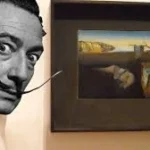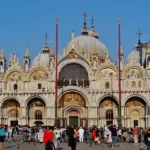
Nicolas Poussin was a pivotal figure in the development of French classical painting during the 17th century. Renowned for his mastery of composition, clarity, and intellectual depth, Poussin’s works have left a lasting impact on the art world. His unique approach combined classical themes with a rigorous artistic philosophy, earning him the title of the father of French classical painting. From his limited number of self-portraits to his significant influence on future artists, Poussin’s legacy continues to be celebrated and studied today. Here are some key aspects of his life and work that highlight his contributions to art history.
Birth Date: Nicolas Poussin was born on June 15, 1594, in Normandy, France, specifically in the town of Les Andelys. Poussin was the son of a prosperous farmer and grew up in a region known for its picturesque landscapes, which would later influence his artistic vision. His early exposure to the natural beauty of his surroundings and the classical art of the Renaissance would shape his future as a painter. He moved to Paris in his youth to pursue his artistic ambitions, which led him to study under various artists and eventually to develop his distinctive style.
Death Date: Poussin passed away on November 19, 1665, in Rome, Italy, where he had spent much of his adult life. His death marked the end of a prolific career that spanned over four decades. He died in the same city that had become his artistic home, where he had established a reputation as one of the leading painters of his time. His burial took place in the church of San Lorenzo in Lucina, where his grave is still visited by art enthusiasts. Poussin’s legacy continued to influence generations of artists long after his death, solidifying his position in art history.
Artistic Movement: Nicolas Poussin is considered a pivotal figure in the Baroque movement, particularly known for his classical approach to painting. His works exemplify the Baroque’s dramatic use of color and light, but he diverged from the typical flamboyance of the movement by emphasizing clarity, order, and rationality. Poussin’s commitment to classical ideals drew heavily from ancient Roman and Greek art, which he studied extensively during his time in Italy. His unique blend of Baroque sensibilities with classical themes set the standard for French painting and laid the groundwork for the Neoclassical movement that followed.
Education: Poussin’s artistic education began in Paris, where he was exposed to the works of various artists and the burgeoning art scene of the early 17th century. In 1624, he moved to Italy, a significant turning point in his career, as he immersed himself in the study of Renaissance art and the classical antiquities of Rome. He was particularly influenced by the works of Raphael, whose compositional techniques and use of color inspired Poussin’s own style. His time in Italy allowed him to refine his skills and develop a distinct aesthetic that combined classical themes with a Baroque sensibility.
First Major Work: Poussin’s first major work, “The Death of Germanicus,” completed in 1627, marked his emergence as a significant artist in the Roman art scene. The painting depicts the moment of Germanicus’s death, a Roman general, surrounded by grieving figures, showcasing Poussin’s mastery of emotional expression and composition. This work was commissioned by Cardinal Francesco Barberini, a prominent patron of the arts, and it helped establish Poussin’s reputation in Rome. The painting is notable for its dramatic use of light and shadow, which enhances the emotional impact of the scene.
Influence: Poussin’s artistic development was significantly influenced by the works of the Italian Renaissance masters, particularly Raphael and Michelangelo. He admired Raphael’s harmonious compositions and the clarity of his figures, which inspired Poussin’s own approach to painting. Poussin also drew from Michelangelo’s powerful forms and dynamic poses, integrating these elements into his own style. This synthesis of influences allowed Poussin to create works that were both emotionally resonant and intellectually rigorous, earning him respect among his contemporaries and later artists.
Poussin’s Style: Known for his distinctive style, Poussin emphasized clarity, order, and rationality in his paintings. He often employed a structured composition, using geometric shapes to guide the viewer’s eye through the artwork. His palette was characterized by a subtle use of color, which contributed to the overall harmony and balance of his works. Poussin’s paintings frequently featured mythological and historical subjects, reflecting his belief in the moral and intellectual power of art. This approach set him apart from many of his contemporaries, who favored more dramatic and emotional expressions.
Number of Major Works: Throughout his prolific career, Poussin created over 200 paintings, many of which are now considered masterpieces. His body of work includes a diverse range of subjects, from classical mythology to religious themes, showcasing his versatility as an artist. Poussin’s paintings often feature complex narratives and carefully constructed compositions, inviting viewers to engage with the stories he depicted. His commitment to craftsmanship and intellectual rigor made his works highly regarded in the art world, influencing generations of artists who followed.
Famous Series: One of Poussin’s most famous series is “The Four Seasons,” which he painted between 1660 and 1664. This series consists of four large canvases, each representing a different season through allegorical figures and landscapes. The paintings are titled “Spring,” “Summer,” “Autumn,” and “Winter,” and they are celebrated for their intricate compositions and rich symbolism. Poussin’s use of color and light varies with each season, capturing the essence of nature’s cycles. The series reflects his deep understanding of the relationship between humanity and the natural world, showcasing his ability to convey complex themes through visual art. The works are now housed in the National Gallery in London, where they continue to be studied and admired for their artistic brilliance.
Size of Works: Poussin’s painting “The Arcadian Shepherds,” created around 1618-1620, measures approximately 97.5 cm × 130.2 cm (38.4 in × 51.3 in). This work is one of his most celebrated pieces and is often interpreted as a meditation on the themes of life, death, and the passage of time. The composition features a group of shepherds who discover an inscription on a tomb, prompting reflections on mortality. The size of the painting allows for detailed figures and a complex landscape, showcasing Poussin’s skill in rendering both human emotion and the beauty of nature. “The Arcadian Shepherds” exemplifies Poussin’s classical approach and his ability to convey profound philosophical ideas through art, making it a significant work in his oeuvre. The painting is currently part of the collection at the Louvre Museum in Paris.
Patronage: Throughout his career, Nicolas Poussin received patronage from several influential figures, most notably King Louis XIII of France and various Italian nobles. His relationship with the Barberini family, particularly Cardinal Francesco Barberini, was crucial in establishing his reputation in Rome. The Cardinal commissioned several works from Poussin, which allowed him to showcase his talent to a wider audience. This patronage not only provided financial support but also helped Poussin gain access to important artistic circles and opportunities. The backing of such powerful patrons enabled him to create significant works that would define his legacy, solidifying his status as one of the leading painters of his time.
Notable Work: “The Holy Family on the Steps,” painted around 1648, is one of Poussin’s significant works that exemplifies his mastery of composition and use of color. This painting depicts the Holy Family—Mary, Joseph, and the infant Jesus—surrounded by various figures in a serene, classical setting. Poussin’s careful arrangement of the figures creates a sense of harmony and balance, while the soft, warm colors evoke a feeling of tenderness. The work reflects his deep religious convictions and his ability to convey spiritual themes through his art. “The Holy Family on the Steps” is part of the collection at the National Gallery in London and is admired for its emotional depth and technical skill.
Louvre Collection: The Louvre Museum in Paris houses several of Poussin’s works, including the iconic painting “The Rape of the Sabine Women.” This large canvas, created between 1637 and 1638, depicts the dramatic moment when Roman men abduct Sabine women to secure wives for themselves. The painting is renowned for its dynamic composition, intricate figures, and emotional intensity. Poussin’s careful use of light and shadow enhances the sense of movement and drama, drawing the viewer into the scene. The Louvre’s collection of Poussin’s works underscores his significance in the history of art and his influence on subsequent generations of painters.
Self-Portrait: Poussin created a self-portrait in 1650, which is currently held in the National Gallery, London. This work is notable for its introspective quality, as Poussin portrays himself with a thoughtful expression, gazing directly at the viewer. The self-portrait reflects his confidence as an artist and his commitment to his craft. Poussin’s choice of attire and the simple background emphasize his serious demeanor and artistic identity. This self-portrait is one of only two known likenesses of the artist, making it a valuable piece for understanding his personal and professional life. It serves as a testament to his legacy and the esteem in which he was held in the art world.
Influence on Neoclassicism: Poussin’s emphasis on classical themes and rational composition significantly influenced the development of Neoclassicism in the 18th century. His approach to art, which prioritized order, clarity, and moral themes, resonated with later artists who sought to revive the ideals of ancient Greece and Rome. Poussin’s works served as a model for Neoclassical painters, who admired his ability to convey complex narratives through structured compositions. Artists such as Jacques-Louis David and Jean-Auguste-Dominique Ingres drew inspiration from Poussin’s style, incorporating elements of his technique into their own works. His legacy as a pioneer of classical painting solidified his place in art history.
Major Themes: Common themes in Poussin’s works include mythology, history, and religious subjects, reflecting his deep engagement with classical literature and philosophy. He often depicted scenes from ancient myths, such as those found in Ovid’s “Metamorphoses,” using allegory to convey moral and philosophical messages. Poussin’s historical paintings frequently explored significant events from Roman history, while his religious works emphasized spiritual themes and the human experience. His ability to intertwine these themes with a rigorous compositional style allowed him to create artworks that were both intellectually stimulating and visually compelling, contributing to his enduring influence on Western art.
Poussin’s Technique: Known for his meticulous technique, Poussin was a master of chiaroscuro, a method that contrasts light and dark to create depth and volume. His careful application of light enhances the three-dimensionality of his figures, drawing attention to their expressions and movements. Poussin often employed a limited palette, using color to evoke mood and atmosphere while maintaining a sense of harmony throughout the composition. His attention to detail and precise brushwork contributed to the clarity and order characteristic of his style. This technical prowess allowed him to convey complex narratives and emotional depth, making his paintings resonate with viewers.
Number of Known Self-Portraits: Nicolas Poussin is known to have created only two self-portraits, which is quite notable considering his prolific career. These portraits reflect not only his physical likeness but also his artistic identity. The first self-portrait, painted around 1650, showcases Poussin in a contemplative pose, emphasizing his intellectual approach to art. The second, created later, further cements his legacy as a master of classical painting. The scarcity of self-portraits in his oeuvre adds an air of mystery to his personal life and invites speculation about his self-perception and the artistic conventions of his time.
Last Major Work: Poussin’s final major work, “The Triumph of David,” was completed shortly before his death in 1665. This painting encapsulates the themes of victory and divine favor, depicting the biblical figure David in a moment of triumph over Goliath. The composition is characterized by its dynamic movement and classical references, showcasing Poussin’s mastery of form and narrative. This work not only serves as a culmination of his artistic career but also reflects his deep engagement with classical themes and the human condition, leaving a lasting impact on the art world.
Cultural Impact: Poussin’s influence on the development of French painting is profound and far-reaching. He is credited with establishing a foundation for the French classical style, emphasizing clarity, order, and harmony in composition. His work inspired subsequent generations of artists, promoting a shift towards idealized forms and themes drawn from mythology and history. Poussin’s emphasis on the intellectual aspects of painting encouraged a more thoughtful approach to art, influencing the way French artists would interpret and represent their subjects for centuries to come.
Artistic Legacy: Often regarded as the father of French classical painting, Poussin’s legacy is characterized by his commitment to the principles of classicism. His works are marked by a rigorous adherence to structure and a focus on the moral and philosophical implications of art. Poussin’s approach laid the groundwork for the Académie Royale de Peinture et de Sculpture, which would further formalize the standards of French painting. His influence can be seen in the works of later artists who sought to emulate his style and thematic choices, reinforcing his status as a pivotal figure in art history.
Famous Quote: Poussin is famously quoted as saying, “A painting should be a reflection of the mind.” This statement encapsulates his belief in the intellectual and emotional depth that art should convey. Poussin viewed painting not merely as a craft but as a means of expressing complex ideas and human experiences. His works often invite viewers to engage with philosophical questions and moral dilemmas, reflecting his conviction that art should provoke thought and contemplation rather than simply please the eye.
Burial Site: Nicolas Poussin was buried in the church of San Lorenzo in Lucina, Rome, a city that played a crucial role in his artistic development. His burial site is a testament to his significant contributions to the art world, as Rome was a center for artists and intellectuals during his lifetime. The church itself holds historical importance, and Poussin’s interment there signifies the respect and recognition he garnered throughout his career. Visitors to the church can reflect on the legacy of this master painter, whose works continue to resonate in the art community.
Poussin’s Students: Poussin’s influence extended to many artists, including Claude Lorrain and Jean-Baptiste-Siméon Chardin. Claude Lorrain, known for his landscape paintings, adopted Poussin’s classical approach to composition and light, which greatly shaped the genre of landscape painting in France. Jean-Baptiste-Siméon Chardin, celebrated for his still lifes and genre scenes, also drew inspiration from Poussin’s emphasis on clarity and form. Poussin’s teaching and mentorship helped cultivate a generation of artists who would carry forward his ideals and techniques, ensuring his impact on the art world would endure.
Auction Record: In 2015, one of Poussin’s paintings achieved a remarkable auction record, selling for approximately $26 million. This sale not only highlights the enduring value of his work but also positions him among the most expensive French artists in history. The painting, titled “The Adoration of the Golden Calf,” exemplifies Poussin’s mastery of narrative and composition, showcasing his ability to convey complex themes through visual storytelling. The high auction price reflects both the historical significance of Poussin’s work and the ongoing interest in classical art among collectors and institutions alike.
FAQs About Nicolas Poussin
Who was Nicolas Poussin?
Nicolas Poussin was a French painter and draftsman considered a foundational figure of the Classical tradition in French art. Despite being French, he spent most of his career in Rome, Italy. His work is known for its intellectual rigor, clear compositions, and deep understanding of classical art and literature. Poussin primarily focused on history paintings, depicting scenes from the Bible, mythology, and ancient history.
What was Nicolas Poussin’s style?
Poussin’s style is often called Classical Baroque. It blends the dramatic elements of the Baroque period with the order and harmony of Classical art. His paintings are recognized for their:
- Clarity and order: His compositions are meticulously planned, with figures and objects arranged in a balanced way.
- Intellectual content: Poussin often included complex mythological or historical narratives in his works, requiring viewers to think deeply about the painting.
- Landscape as a character: While famous for his history paintings, Poussin also excelled in landscape painting, often using it as a symbolic background for his stories.
What were Nicolas Poussin’s main themes?
Poussin explored various themes in his work, including:
- Mythology: He painted many scenes from Greek and Roman mythology, often with moral or philosophical messages.
- Biblical narratives: Poussin created powerful and dramatic interpretations of biblical stories.
- History painting: He depicted historical events, both real and imagined, focusing on heroic figures and dramatic action.
- Landscape: Poussin’s landscapes are often idealized and peaceful, contrasting with the dramatic elements of his history paintings.
What are some of Nicolas Poussin’s most famous paintings?
Some of Poussin’s most well-known works include:
- The Rape of the Sabine Women
- Et in Arcadia Ego
- Landscape with Polyphemus
- The Shepherds of Arcadia
- The Triumph of Bacchus
Where can I see Nicolas Poussin’s paintings?
Poussin’s works are displayed in major art museums worldwide. Some of the most important collections can be found at:
- The Louvre Museum, Paris
- The National Gallery, London
- The Metropolitan Museum of Art, New York
- The Hermitage Museum, Saint Petersburg
What was Nicolas Poussin’s influence on later artists?
Poussin’s impact on future generations of artists is significant. His emphasis on clarity, order, and intellectual content influenced the development of Neoclassicism. Artists like Jacques-Louis David and Claude Lorrain were directly inspired by his work. Poussin’s legacy continues to shape our understanding of art and its role in society.







